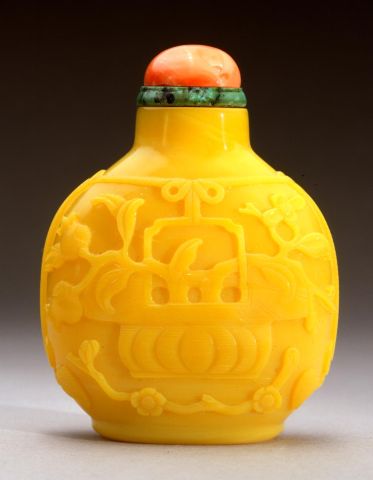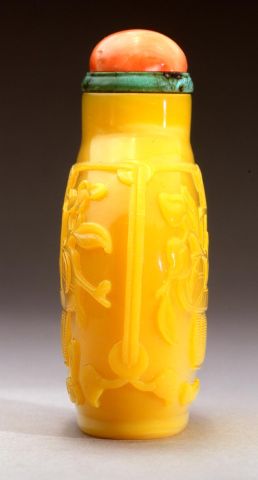

Bottle ID: 00211
YELLOW IMPERIAL, CARVED W/BASKET OF FLOWERS & FRUIT
Date: 1750-1820
Height: 65 mm
Glass, opaque yellow, of large flattened rounded form, carved in relief on each side with a woven basket suspended from a rope linking through a bi disc and tassels, the basket on one side containing a spray of pomegranates with two fruits and a spray of begonias with one flower, a branch of blossoming prunus laying in front of it; the basket on the other side with a spray of peaches, with two fruits and a lotus flower with a leaf, with a lotus root set in front of the basket.
Probably Imperial, attributed to the Palace Workshops, Beijing.
Similar Examples:
Snuff Bottles of The Ch'ing Dynasty: Catalogue of an Exhibition at the Hong Kong Museum of Art, 1978, p. 67, no. 62.
Kleiner, Robert. Treasures from the Sanctum of Enlightened Respect, Chinese Snuff Bottles from the Collection of Denis Low, 1999, p. 99, no. 81.
Moss, Hugh, Victor Graham and Ka Bo Tsang. The Art of the Chinese Snuff Bottle - The J & J Collection, 1993, Vol II, p. 642, no. 393.
Provenance:
Hugh Moss [HK] Ltd.
Exhibited:
Annual Convention ICSBS Toronto, October 2007
Published:
JICSBS, Autumn 2006, Front Cover
One problem that today's collectors have is discerning between yellow glass bottles of the eighteenth century and those of a later date. The reason for the profusion of so-called Imperial yellow glass snuff bottles is two-fold. First, that there were certainly many bottles made by the boxful in the eighteenth century and second, when the rules were relaxed early in the nineteenth century, yellow became a popular choice for those determined to flaunt the regulations. While this was hard to do with ceremonial attire because the populace simply would not wear sacrificial robes, which copied the Imperial family, it was relatively easy with objects that had never been officially regulated such as snuff bottles. The Court from the Daoguang period onwards had financial problems and ranks were sold, creating confusion in the hierarchical nature of the Court. As order was abused, the right to wear yellow was abused and there were rumors that even the Daoguang Emperor was involved in selling the use of yellow, an undignified scam if ever there was one. While the quality of carving of this bottle suggests an eighteenth century date, the size and the color tone of the glass puts it hesitantly in the early nineteenth century.
Lan caihe was one of the Eight Immortals and is usually depicted carrying a basket of flowers. Since she could grant longevity, the basket itself has become associated with it. In this case, the basket is heavily laden with symbolism as peaches are symbolic of immortality, lotus is asscoiated with purity and pomegranates with fertility.
< Back to full list
 English
English 中文
中文